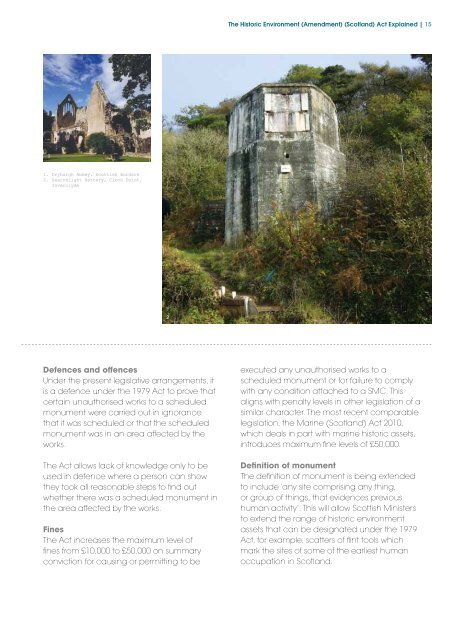Managing and Protecting our Historic ... - Historic Scotland
Managing and Protecting our Historic ... - Historic Scotland
Managing and Protecting our Historic ... - Historic Scotland
Create successful ePaper yourself
Turn your PDF publications into a flip-book with our unique Google optimized e-Paper software.
The <strong>Historic</strong> Environment (Amendment) (Scotl<strong>and</strong>) Act Explained | 15<br />
1<br />
1. Dryburgh Abbey, Scottish Borders<br />
2. Searchlight Battery, Cloch Point,<br />
Inverclyde<br />
2<br />
Defences <strong>and</strong> offences<br />
Under the present legislative arrangements, it<br />
is a defence under the 1979 Act to prove that<br />
certain unauthorised works to a scheduled<br />
monument were carried out in ignorance<br />
that it was scheduled or that the scheduled<br />
monument was in an area affected by the<br />
works.<br />
The Act allows lack of knowledge only to be<br />
used in defence where a person can show<br />
they took all reasonable steps to find out<br />
whether there was a scheduled monument in<br />
the area affected by the works.<br />
Fines<br />
The Act increases the maximum level of<br />
fines from £10,000 to £50,000 on summary<br />
conviction for causing or permitting to be<br />
executed any unauthorised works to a<br />
scheduled monument or for failure to comply<br />
with any condition attached to a SMC. This<br />
aligns with penalty levels in other legislation of a<br />
similar character. The most recent comparable<br />
legislation, the Marine (Scotl<strong>and</strong>) Act 2010,<br />
which deals in part with marine historic assets,<br />
introduces maximum fine levels of £50,000.<br />
Definition of monument<br />
The definition of monument is being extended<br />
to include ‘any site comprising any thing,<br />
or group of things, that evidences previous<br />
human activity’. This will allow Scottish Ministers<br />
to extend the range of historic environment<br />
assets that can be designated under the 1979<br />
Act, for example, scatters of flint tools which<br />
mark the sites of some of the earliest human<br />
occupation in Scotl<strong>and</strong>.













![Elgin Cathedral Wedding Brochure [pdf, 544kb] - Historic Scotland](https://img.yumpu.com/22301571/1/190x151/elgin-cathedral-wedding-brochure-pdf-544kb-historic-scotland.jpg?quality=85)



